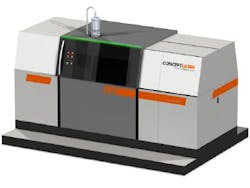Lichtenfels, Germany -Laser additive manufacturing with metals is becoming important in the automotive industry, because the time and cost reductions in production make this technology attractive to carmakers. The primary focus is on aluminum alloys that provide the basis for lightweight automobile applications involving vehicle and engine technology.
Daimler AG is now embracing the resource-efficient, generative metal laser melting of metals. In order to meet all future assignments, the company cooperated with the Fraunhofer Institute for Laser Technology (ILT) and the LaserCUSING specialist Concept Laser in the development of a new super laser melting machine with a build chamber size that surpasses anything previously known.
The X line 1000R machine has a build chamber with impressive dimensions, developed for the tool-less manufacturing of large functional components and technical prototypes with material properties identical throughout the range. A high-power laser in the kilowatt range enables an increase in productivity of up to a factor of 10 compared with standard laser fusing machines available on the market.
The machine was specifically configured to cater to Daimler AG's special requirements for automobile applications: replacing costly sand-casting and die-casting applications in early phases of development. Additionally, the LaserCUSING process (a mashup of the letter "C" in Concept Laser's name and the word fusing i.e. complete melting) will in the future offer the possibility of generating lightweight structures with a high level of rigidity, permitting weight-optimized geometries, with almost no restrictions on the design, which cannot be manufactured with conventional manufacturing techniques.
The project partners got together as part of the "Alu generative research and development project" (German Ministry of Education and Research). Fraunhofer ILT examined, together with different partners from industry including Daimler AG, the laser fusing technology for production applications involving aluminum components. The well-known characteristics of the production process include: conservation of resources, independence from mold-making, freedom of geometry, as well as the speed of construction and development. The examinations were appraised at Daimler as a fundamentally new way of looking at manufacturing options with the aim of creating innovative and environmentally friendly products.
Daimler AG required: a significant increase in the build-up rates, an improvement in the quality of the surface finish, reproducibility and reliability of the machine as a result of appropriate process monitoring, as well as the qualification of further aluminum series alloys for a range of applications.
The functional specification was drawn up at Concept Laser together with the partners, and the design phase for the new X line 1000R was started. The development of a machine concept of these dimensions was done in close collaboration with Daimler AG and the Fraunhofer ILT, based on the LaserCUSING technology. As a result of the cooperation project it is hoped that the generative machine technology will meet customers' requirements on a broad basis and that can be employed profitably. For the development of parts at Daimler AG, the high and flexible availability of such a machine opens up entirely new possibilities for further optimization of the product development process.
